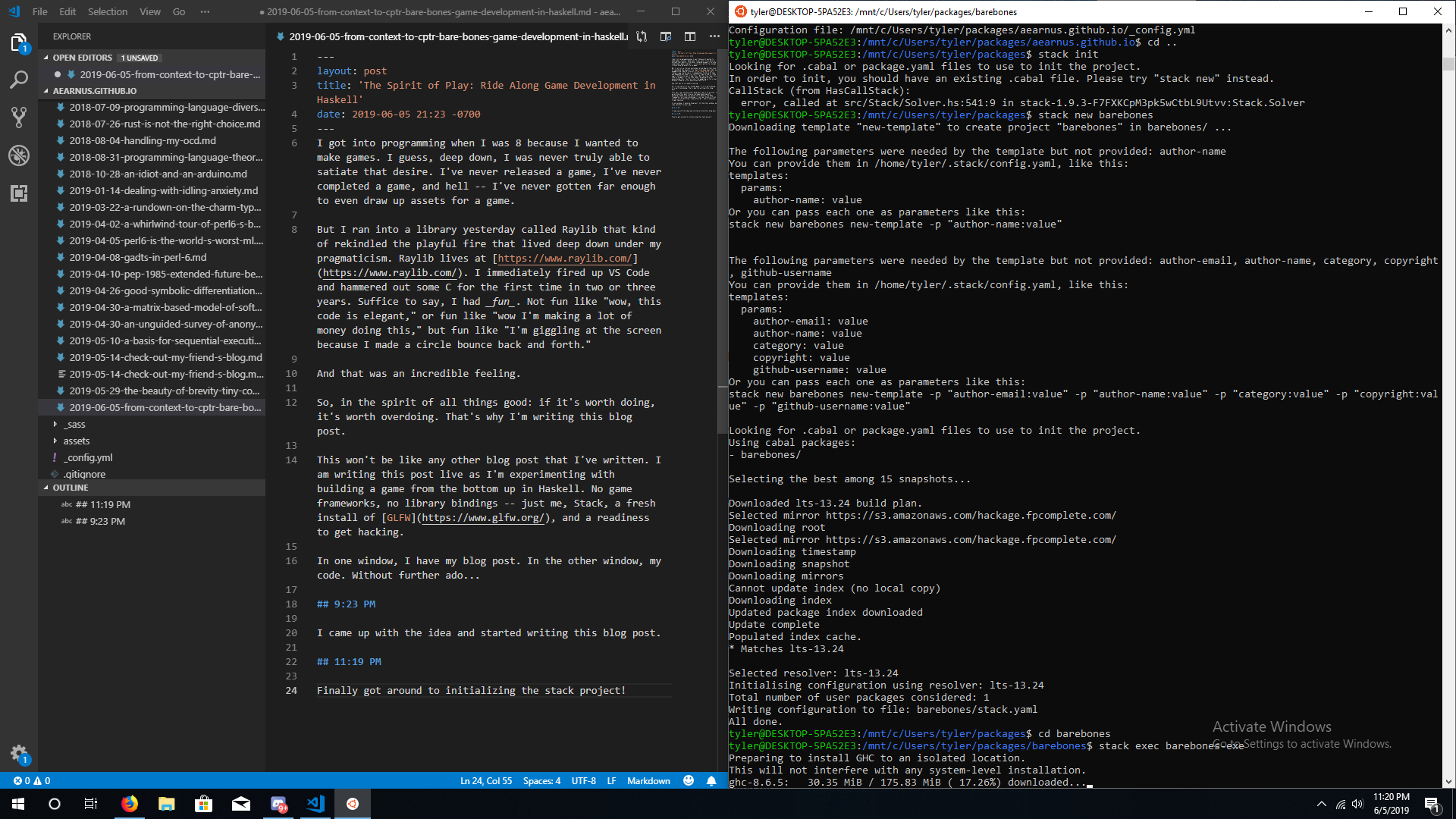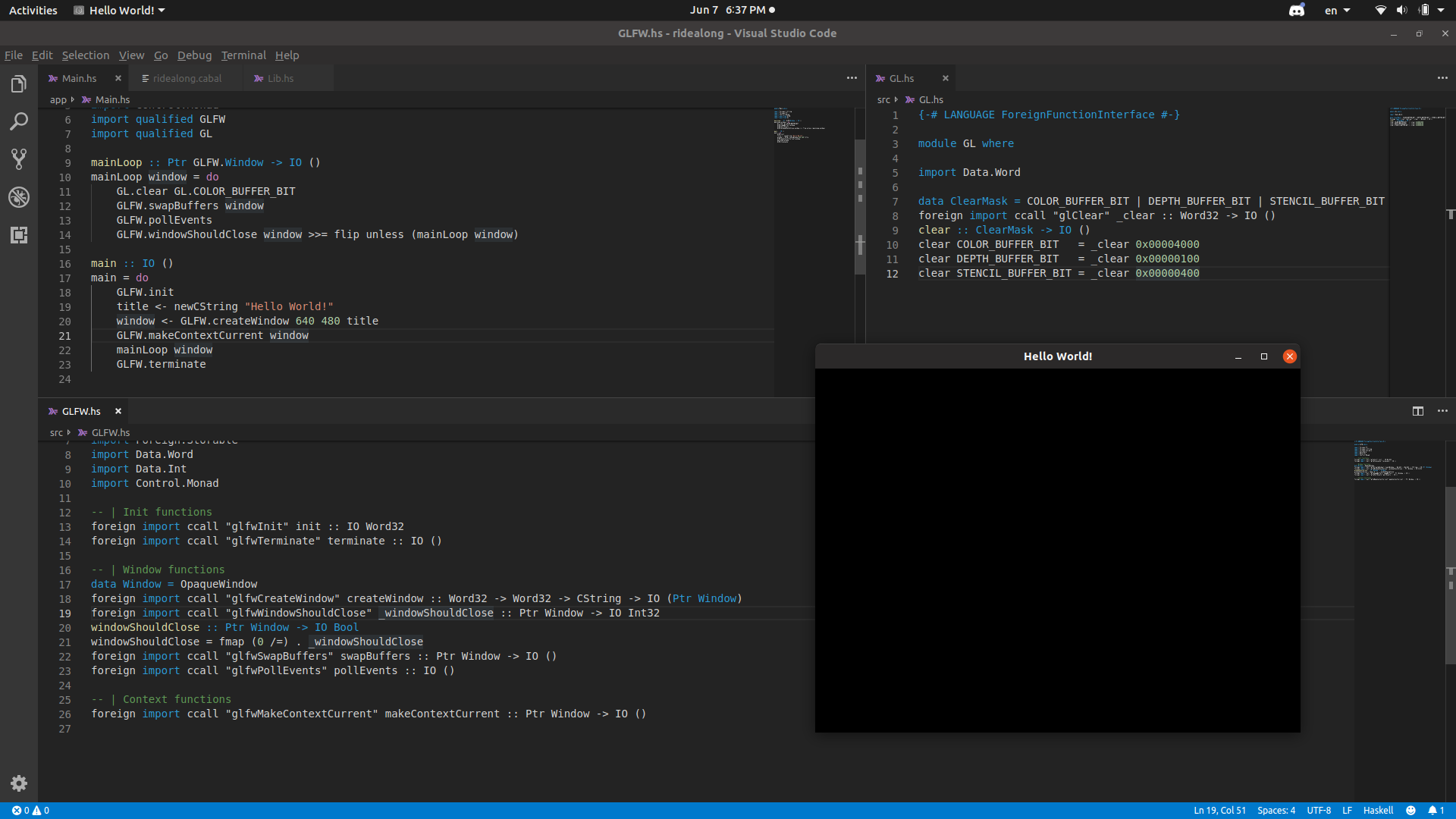[old draft] Ride along wrapper-free game development in Haskell
Hey all! I was going through my blog post backlog and found this draft from 2019-06-05. Thought I’d just throw it up on the blog: there’s some useful stuff about Haskell’s FFI here, and I also wax poetic about software development a little bit. This was written before the whole 100 blog posts thing so it doesn’t count.
The original title of this was to be “From Context to Cptr: Bare Bones Game Development in Haskell”. I will let 2019 me take it from here.
I got into programming when I was 8 because I wanted to make games. I guess, deep down, I was never truly able to satiate that desire. I’ve never released a game, I’ve never completed a game, and hell – I’ve never gotten far enough to even draw up assets for a game.
But I ran into a library yesterday called Raylib that kind of rekindled the playful fire that lived deep down under my pragmaticism. Raylib lives at https://www.raylib.com/. I immediately fired up VS Code and hammered out some C for the first time in two or three years. Suffice to say, I had fun. Not fun like “wow, this code is elegant,” or fun like “wow I’m making a lot of money doing this,” but fun like “I’m giggling at the screen because I made a circle bounce back and forth.”
And that was an incredible feeling.
So, in the spirit of all things good: if it’s worth doing, it’s worth overdoing. That’s why I’m writing this blog post.
This won’t be like any other blog post that I’ve written. I am writing this post live as I’m experimenting with building a game from the bottom up in Haskell. You’ll see every single decision I make, and everything I find exciting enough to share, even if I go back on it five minutes later. No game frameworks, no library bindings – just me, Stack, a fresh install of GLFW, and a readiness to get hacking.
In one window, I have my blog post. In the other window, my code. Without further ado…
9:23 PM, day 1 #
I came up with the idea and started writing this blog post.
11:19 PM #
Finally got around to initializing the stack project!

12:57 AM #
Here’s my first attempt at defining enough of a wrapper around GL and GLFW in order to run the example code on the GLFW documentation page. This is before I’ve even tried compiling it, so this is pre-iteration-1:
GLFW.hs:
{-# LANGUAGE ForeignFunctionInterface #-}
module GLFW where
import Control.Monad
-- | Init functions
foreign import ccall "glfwInit" init :: IO Int
foreign import ccall "glfwTerminate" terminate :: IO ()
-- | Window functions
data Window = InternalWindow deriving (Storable)
foreign import ccall "glfwCreateWindow" createWindow :: Int -> Int -> CString -> IO (Ptr Window)
foreign import ccall "glfwWindowShouldClose" _windowShouldClose :: Ptr Window -> IO Int
windowShouldClose :: Ptr Window -> IO Bool
windowShouldClose = fmap (0 /=) . _windowShouldClose
foreign import ccall "glfwSwapBuffers" swapBuffers :: Ptr Window -> IO ()
foreign import ccall "glfwPollEvents" pollEvents :: IO ()
-- | Context functions
foreign import ccall "glfwMakeContextCurrent" makeContextCurrent :: Ptr Window -> IO ()
GL.hs:
{-# LANGUAGE CPP, ForeignFunctionInterface #-}
module GL where
#include <GL/gl.h>
data ClearMask = COLOR_BUFFER_BIT | DEPTH_BUFFER_BIT | STENCIL_BUFFER_BIT
foreign import ccall "glClear" _clear :: Int -> IO ()
clear :: ClearMask -> IO ()
clear COLOR_BUFFER_BIT = _clear GL_COLOR_BUFFER_BIT
clear DEPTH_BUFFER_BIT = _clear GL_DEPTH_BUFFER_BIT
clear STENCIL_BUFFER_BIT = _clear GL_STENCIL_BUFFER_BIT
1:08 AM #
Turns out including header files in Haskell isn’t as easy as using #include <GL/gl.h>.

6:38 PM, day 3 #
After a day long break where I was busy with some freelance work, I came back to this project and finally made some progress! After fixing some linker errors a couple Haskell bugs…
We have a window!

Interlude: Why Haskell? #
I believe that the monadic approach to programming, in which actions are first class values, is itself interesting, beautiful, and modular. In short, Haskell is the world’s finest imperative programming language.
from https://www.microsoft.com/en-us/research/wp-content/uploads/2016/07/mark.pdf.
I didn’t want to do this in C because C is the language that can directly interface with GLFW and OpenGL. I didn’t want to be able to do this because I wanted a reason to sit and ponder each function before I use it. Having to write sensible bindings for every single graphics function that I use encouraged me to take this time.
So the question remained of what langauge I should decide to use. I could have went with a run-of-the-mill scripting language, but something about the elegant abstractions of Haskell drew me toward using it for this project.
For one, Haskell is my favorite language, so it’s naturally one of my top choices for anything that I do. But further than that, the biggest roadblock that I hit trying to learn OpenGL the first time a while back was the difficulty of composing abstractions on top of the admittedly obtuse graphics pipeline. Haskell is notorious for being able to abstract. So abstract I shall.
11:53 PM, day 3 #
Started reading through https://learnopengl.com/Getting-started/Hello-Triangle. Buffers make a lot more sense than I remember them making.